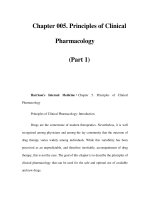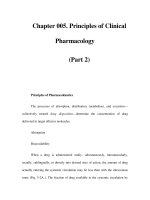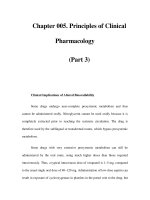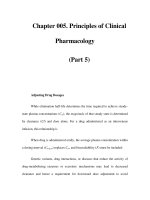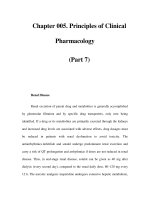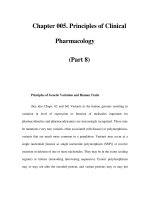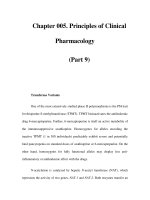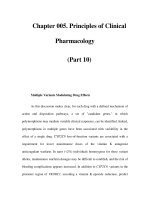Chapter 081. Principles of Cancer Treatment (Part 19) pptx
Bạn đang xem bản rút gọn của tài liệu. Xem và tải ngay bản đầy đủ của tài liệu tại đây (53.08 KB, 5 trang )
Chapter 081. Principles of
Cancer Treatment
(Part 19)
Solid Tumors
Small-molecule epidermal growth factor (EGF) antagonists act at the ATP
binding site of the EGF receptor tyrosine kinase. In early clinical trials, gefitinib
showed evidence of responses in a small fraction of patients with non-small cell
lung cancer. Side effects were generally acceptable, consisting mostly of rash and
diarrhea. Gefitinib was found to have antitumor activity mainly in the subset of
patients with tumors containing activating mutations in the EGF receptor. Often
patients who developed resistance to gefitinib have acquired additional mutations
in the enzyme, similar to what was seen in imatinib-resistant CML. Erlotinib is
another EGF receptor tyrosine kinase antagonist with somewhat superior activity
to gefitinib in clinical trials in non-small cell lung cancer. Even patients with wild-
type EGF receptors may benefit from erlotinib treatment. Lapitinib is a combined
EGF receptor and erbB2 tyrosine kinase antagonist with activity in breast cancers
refractory to anti-erbB2 antibodies.
In addition to the p210
bcr-abl
kinase, imatinib also has activity against the c-
kit tyrosine kinase, activated in gastrointestinal stromal sarcoma, and the platelet
derived growth factor receptor (PDGF-R), activated by translocation in certain
sarcomas. Imatinib has found clinical utility in these neoplasms previously
refractory to chemotherapeutic approaches.
"Multitargeted" kinase antagonists are small-molecule ATP site-directed
antagonists that inhibit more than one protein kinase. Drugs of this type with
prominent activity against the vascular endothelial growth factor receptor (VEGF-
R) tyrosine kinase have activity in renal cell carcinoma. Sorafenib is a VEGF-R
antagonist with activity against the raf serine-threonine protein kinase as well.
Sunitinib has anti-VEGF-R as well as anti-PDGF-R and anti-c-kit activity. It
causes prominent responses as well as stabilization of disease in renal cell cancers
and gastrointestinal stromal tumors. Side effects for both agents are mostly
acceptable, with fatigue and diarrhea encountered with both agents. The "hand-
foot syndrome" with erythema and desquamation of the distal extremities, in some
cases requiring dose modification, may be seen with sorafenib. Temsirolimus, an
mTOR inhibitor, has activity in renal and breast cancer. It produces some
hyperlipidemia (10%), myelosuppression (10%), and rare lung toxicity.
Acute Complications of Cancer Chemotherapy
Myelosuppression
The common cytotoxic chemotherapeutic agents almost invariably affect
bone marrow function. Titration of this effect determines the MTD of the agent on
a given schedule. The normal kinetics of blood cell turnover influence the
sequence and sensitivity of each of the formed elements. Polymorphonuclear
leukocytes (PMNs; t
1/2
= 6–8 h), platelets (t
1/2
= 5–7 days), and red blood cells
(RBCs; t
1/2
= 120 days) respectively have most, less, and least susceptibility to
usually administered cytotoxic agents. The nadir count of each cell type in
response to classes of agents is characteristic. Maximal neutropenia occurs 6–14
days after conventional doses of anthracyclines, antifolates, and antimetabolites.
Alkylating agents differ from each other in the timing of cytopenias. Nitrosoureas,
DTIC, and procarbazine can display delayed marrow toxicity, first appearing 6
weeks after dosing.
Complications of myelosuppression result from the predictable sequelae of
the missing cells' function. Febrile neutropenia refers to the clinical presentation
of fever (one temperature ≥38.5°C or three readings ≥38°C but ≥38.5°C per 24 h)
in a neutropenic patient with an uncontrolled neoplasm involving the bone marrow
or, more usually, in a patient undergoing treatment with cytotoxic agents.
Mortality from uncontrolled infection varies inversely with the neutrophil count. If
the nadir neutrophil count is >1000/µL, there is little risk; if <500/µL, risk of death
is markedly increased. Management of febrile neutropenia has conventionally
included empirical coverage with antibiotics for the duration of neutropenia
(Chap. 82). Selection of antibiotics is governed by the expected association of
infections with certain underlying neoplasms; careful physical examination (with
scrutiny of catheter sites, dentition, mucosal surfaces, and perirectal and genital
orifices by gentle palpation); chest x-ray; and Gram stain and culture of blood,
urine, and sputum (if any) to define a putative site of infection. In the absence of
any originating site, a broadly acting β-lactam with anti-Pseudomonas activity,
such as ceftazidime, is begun empirically. The addition of vancomycin to cover
potential cutaneous sites of origin (until these are ruled out or shown to originate
from methicillin-sensitive organisms) or metronidazole or imipenem for
abdominal or other sites favoring anaerobes reflects modifications tailored to
individual patient presentations. The coexistence of pulmonary compromise raises
a distinct set of potential pathogens, including Legionella, Pneumocystis, and
fungal agents that may require further diagnostic evaluations such as
bronchoscopy with bronchoalveolar lavage. Febrile neutropenic patients can be
stratified broadly into two prognostic groups. The first, with expected short
duration of neutropenia and no evidence of hypotension or abdominal or other
localizing symptoms, may be expected to do well even with oral regimens, e.g.,
ciprofloxacin or moxifloxacin, or amoxicillin plus clavulinic acid. A less favorable
prognostic group are patients with expected prolonged neutropenia, evidence of
sepsis, and end-organ compromise, particularly pneumonia. These patients clearly
require tailoring of their antibiotic regimen to their underlying presentation, with
frequent empirical addition of antifungal agents if fever persists for 7 days without
identification of an adequately treated organism or site.
